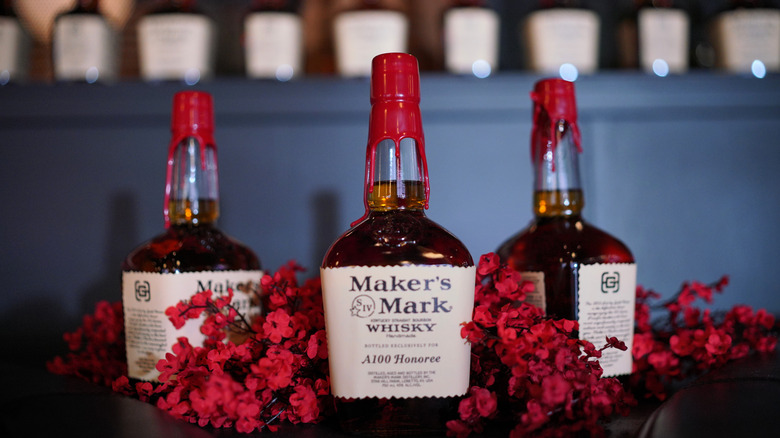Here's How Maker's Mark Bourbon Got Its Famous Red Wax Drip
Maker's Mark makes its mark on grocery and liquor store shelves with strategic, eye-catching packaging. Standing amid an aisle of other liquor handles, consumers' attention is immediately drawn to Maker's Mark, whose caps are sealed with a drop of bright red wax.
Each bottle produced by Maker's Mark has been decorated with red wax since the company's inception in 1958. When the bourbon brand was launched, Margie Samuels, who co-founded Maker's Mark with her husband, designed the now-signature bottle, including the red wax at the top. At that time, bourbon was categorized as a liquor similar to moonshine — not the classy, fine-taste libation as it is known today. The red wax dip was an attempt to help the brand stand apart from its competitors.
As a design prototype, the Samuels dipped the first Maker's Mark bottle in a deep fryer on their kitchen stove. The wax mixture took six months to develop. The Maker's Mark team had to create a wax formula that would melt at a certain temperature, so the wax wouldn't melt while the bottles were transported or on shelves or in consumers' homes.
From the prototype to the handles produced today, every bottle of Maker's Mark is hand dipped. At the bottling facility, dippers are hired to stand at the end of the production line to dip every bottle. Because the bottles are hand dipped, the brand produces around 125 bottles per minute, whereas its competitors can reach up to 400 per minute.
More behind the Maker's Mark history
We named Maker's Mark as a drink of choice at both derbies and dive bars, as well as a gateway bourbon for those trying to get into drinking the liquor for its easier-to-go-down flavor. In addition to being sippable on its own, Maker's Mark is perfect in the classic boulevardier cocktail or spiked eggnog. But beyond the bourbon's positive qualities and characteristics in drinking culture, there is much more behind the hallmark red wax drip.
Margie Samuels designed the red wax and Maker's Mark logo while studying at the University of Louisville. In addition to the red wax, Margie Samuels also suggested the S for their last name, the Roman numeral IV representing her husband's status as a member of the fourth generation of a line of family distillers, and the star to represent the name of their hometown, Star Hill. In 1985, the family officially trademarked the unique red wax topper.
Aside from its aesthetic purposes, the bright red wax also has functional purposes. Just as the caps found on glass bottles in bagel shops and bodegas help customers know whether or not it's been opened, the red wax serves as an indicator to show whether the bottle of bourbon has been previously accessed. The red wax cracks when the bottle opens, letting people know if the bottle is fresh or not.

